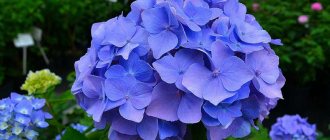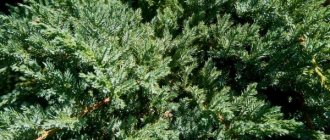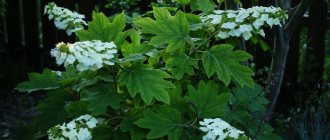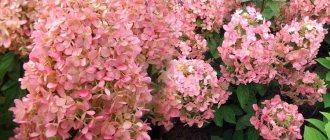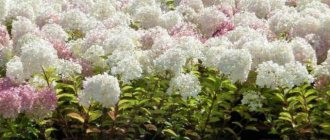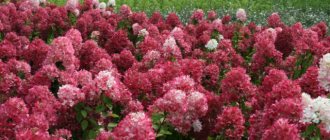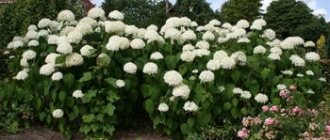The Pastel Green variety was developed quite recently, in 2021, thanks to the French breeder J. Renault. Some time later, he received a silver award at an international exhibition that took place in Holland. This variety was so highly valued for its incredible beauty of inflorescences. Their colors change each other during flowering. At first the petals are white, a little later they acquire cream, salmon or even pistachio shades, and at the end they become the color of wine. But this is not all of its advantages. Hydrangea Pastel Green begins to bloom in June and ends only in September, but if it is grown in regions with a warm climate, then it pleases with the beauty and splendor of its flowering from May until the onset of frost.
Hydrangea Pastel Green: photo
Hydrangea paniculata deluxe series Pastel Green is a small shrub with always lush flowering and high frost resistance.
Hydrangea Pastel Green: variety description
Paniculata hydrangea Pastel Green is a very neat bush of compact size. The French nursery gives information which states that the height of the plant does not exceed 1.2 meters, as well as its width. Hydrangea of this variety has spherical inflorescences, they are distinguished by their splendor, and the length of the peduncle reaches 20 centimeters. The flowers consist of four rounded petals. In summer the leaves are painted bright green; in autumn they begin to turn yellow.
The small parameters of the flower allow you to grow it at home using small containers, or in small gardens.
Hydrangea paniculata variety Pastel Green has increased resistance to frost. Despite their delicate harmonious appearance and apparent fragility, they are able to withstand temperatures down to -30 degrees. Thanks to this frost resistance, Pastel Green can be grown in the territories of the Middle Zone, the Urals and Siberia.
How to properly care?
Healthy bushes, planted according to all the rules, grow and develop quickly, annually adding 30-40 cm in height and width. With such indicators, there is no doubt about the future rapid flowering of the bush, but this must be preceded by proper care.
Moisturizing and watering
A sufficient amount of moisture ensures high-quality flower formation; the soil should not be allowed to dry out. In extreme heat, watering is carried out once a week; for an adult bush, at least 2 buckets of water are required
Young bushes are watered carefully, checking the dryness of the soil to a depth of 15-20 cm. In cool weather, the volume of water is halved
Fertilizing
The rapid development of the aboveground part during the growing season is due to the fact that the plant consumes a large amount of nutritional components, so additional soil fertilization is necessary. For this purpose, mineral compounds and organic additives are used - humus and rotted leaf compost, 4 times during the year. It is mandatory to feed during the appearance of buds and buds, in mid-July and after the crop has flowered in the fall, in order to support the exhausted plant.
During the first application of fertilizers, it is allowed to use poultry droppings or manure infused for 24 hours. Each bush requires 12 liters of liquid solution. When buds form, potassium salt, saltpeter and superphosphate are needed for active flowering. In the summer, complex fertilizers are required for hydrangeas; in the fall, potassium salt and any products containing phosphorus are used again.
Loosening and mulching
Loosening is a mandatory and regular procedure. It is carried out after irrigation and, if necessary, for the entire time until the next watering to a depth of at least 10 cm, along with this weeding is carried out. It is necessary to mulch the surface near the trunk to maintain moisture, which is important for the summer season. The layer is made up to 30 cm thick from dry wood shavings, peat, leaves and humus.
Trimming
The paniculate variety "Grandiflora" needs to be trimmed periodically in the spring, before sap flow begins, cutting off old and weak branches, as well as shoots with damaged bark. Old specimens need to be rejuvenated; to do this, their branches are shortened. Mature branches are pruned into 2-3 buds.
Preparing for winter
Protecting a plant during cold weather does not involve constructing a shelter, and during a snowy winter, the crop is saved from freezing by the snow mass. It is enough to pour a thick layer of mulch under the bush to protect the roots - fallen leaves and humus are used as the material. “Grandiflora” tolerates sub-zero temperatures down to -30 degrees, but young seedlings must be protected during the first 2 years, so it is better to cover them with any non-woven fabric, on top of which a snowdrift forms when snow falls.
Site selection and watering
Hydrangea Pastel Green: photo
Paniculata hydrangea Pastel Green is an unpretentious plant. It will be able to grow in any conditions and ordinary garden soil will be quite suitable for it. However, she also has preferences. She loves to grow in fertile, humus soils. Unlike many of its “brothers”, hydrangea of this variety can develop well and demonstrate the brightness of colors on its inflorescences even when exposed to direct sunlight all day long. She will also feel great in partial shade. Watering is very important for hydrangeas. The ornamental plant does not tolerate too moist soil, so watering should be regular and moderate. When watering, you need to make sure that the water gets only under the base of the bush and does not wet the leaves.
It is important to know that this variety tolerates short dry periods.
Diseases and pests
If proper agricultural practices are followed, the plant will delight the gardener with lush flowers. Despite constant care, sometimes hydrangea can be affected by various diseases. Although selection has significantly improved Pastel Green's immunity, she is susceptible to the following ailments:
- viral diseases - ring spot and hydrangea cancer;
- fungal diseases - powdery mildew, septoria, white and gray rot.
In addition to traditional diseases, hydrangea bushes can be affected by various pests. The most common uninvited guests are spider mites, leaf aphids, root-knot nematodes and garden slugs. To get rid of insects, specialized insecticides are used at the first sign of their detection.
Hydrangea Pastel Green: propagation and planting
Reproduction of hydrangea paniculata Pastel Green is no different from other varieties of the same species: using seeds, cuttings, layering. In the first case, the seeds are sown in containers with moist soil without a hole. Then the containers are covered with glass or film to create comfortable conditions. The first shoots can be seen after 14 days. You can plant grown plants in the garden only two years after sowing. By this time they should reach 30 centimeters in length.
The second option, cuttings, is most often used by gardeners. Cuttings are taken from shoots that are cut from bushes.
The most suitable time for such events would be early morning in July. It is necessary to remove the top part from the cut shoot, cut the rest so that 4 leaves remain on each part. The leaves located in the lower part on the cuttings are removed, and the remaining ones are thinned by 50%. Next, the cuttings are lowered into a growth-stimulating solution without dropping the leaves. As soon as a thickening and small roots appear at the end, the cuttings are planted in a container 10 centimeters deep and filled with a moist soil mixture of peat and sand in proportions 2/1. Afterwards, the containers are placed in greenhouse conditions for growing. If the procedure is carried out in the summer, then they can be placed in the garden and covered with spunbond; with the onset of cold weather, they must be brought into the house or greenhouse. For good rooting, you need to water the cuttings regularly and then after 30 days you can observe the appearance of new leaves. As soon as they appear, the film must be removed. A young plant is planted in the garden in the spring, when it has grown and the threat of frost has completely disappeared.
It is interesting to know that a bush obtained as a result of division or one purchased in a store can be planted in early autumn directly in a pot and covered. In the spring you can simply transplant it to a permanent place.
Hydrangea Pastel Green: caring for the paniculate variety
Paniculata hydrangea Pastel Green: photo
Paniculata hydrangea Pastel Green is an unpretentious plant, but nevertheless it should not be ignored. It needs regular watering, but water stagnation should not be allowed. This variety is tolerant of slight drying out of the soil. Watering should be carried out exclusively at the base of the bush once every 7 days. It is important not to forget that moisture should not get on the leaves and inflorescences, as it is harmful to them.
Fertilizers must be applied in the fall and during the growing season. In the first autumn months, mineral fertilizers are suitable, and in early spring, urea diluted with water 20g. x 1 in. Each adult bush requires 20 liters of this fertilizer. When flowering begins, mineral fertilizers are applied twice at intervals of two weeks.
After watering the Pastel Green hydrangea, cover the soil with a layer of mulch made from crushed tree bark, peat moss or sawdust. This will keep moisture in the soil longer and slow down the growth of weeds.
paniculate hydrangeas
Little Passion
Hydrangeas of the Little Passion variety are perennial shrubs no more than 60 cm high and 80 cm in diameter. Suitable for growing in open ground and in pots. The inflorescences are dense, initially light green in color, then pink shades are added, and the initial one is preserved only in the central zone of each flower.
Flowering from July to October.
Cotton Cream
Compact, folded almost perfectly, reaches a height of about 80–100 cm. The crown of hydrangea is dense, dense, spherical in shape, consists of numerous branched shoots. The color varies depending on the period of the growth phase: when the buds open, it is greenish, as the culture develops it becomes creamy, and after flowering it turns pinkish.
Flowering from July to September.
Little Blossom
A very compact hydrangea with very dark green leaves. The flowers are white, gradually turning pink over time. Bush 80 cm high and 70 cm in diameter.
Flowering from June to September.
Strawberry Blossom
Due to the fact that its buds are somewhat reminiscent of strawberries, the Strawberry Blossom hydrangea is called “strawberry blossom”.
The bush grows up to 1–1.5 m in height and has fairly strong shoots. The inflorescences are cone-shaped, reminiscent of strawberries, with a diameter of about 28–31 cm.
Flowering from June to September.
Hydrangea paniculata luxury series Pastel Green: pruning
Paniculata hydrangea Pastel Green: photo
Pruning paniculate hydrangea Pastel Green is carried out in early spring before the buds begin to bloom. The decorative appearance of the bush during flowering will depend on the time chosen. In autumn, pruning is not carried out, as this reduces the endurance of the bush, which is very important during the winter cold.
During spring sanitary pruning, all branches of hydrangea variety Pastel Green with signs of damage and dry, as well as inflorescences from last year, are removed. During formative pruning, all old, weak branches and those growing inside the bush are removed, and those that are strong and strong are left. This pruning is carried out until the bush acquires the desired shape. It must be carried out in the first years of life, during a period of rapid development, since strong shoots need the right direction.
Anti-aging pruning of adult bushes is carried out every year. During it, the buds are shortened to 5, this helps to increase the size of the flower. To radically rejuvenate the bush, all four-year-old shoots must be cut off completely.
In the fall, pruning is not carried out, the bushes are only cleared of faded inflorescences so that the plant is easier under a layer of snow and the branches do not break.
Where to buy Pastel Green hydrangea?
You can buy paniculate hydrangeas of the Pastel Green variety: in the Moscow agricultural company Search; in the Moscow nursery Leskovo: in the Samara garden center named after Vera Glukhova; in the Tyumen nursery Akhmechet and in the Togliatti nursery Ely-Pala. There are not too many options, but only they have been given official permission from the French nursery named Reno to sell these unpretentious, frost-resistant and ornamental plants. Restrictions are made to prevent fakes.
